lock Oldsmobile Bravada 2003 Owner's Manuals
[x] Cancel search | Manufacturer: OLDSMOBILE, Model Year: 2003, Model line: Bravada, Model: Oldsmobile Bravada 2003Pages: 410, PDF Size: 20.1 MB
Page 6 of 410

These are some examples of vehicle symbols you may find on your vehicle:
POSSIBLE A
CAUTION INJURY
PROTECT EYES BY
SHIELDING
CAUSTIC
4ClD COULD BAlTERY
CAUSE
BURNS
AVOID
SPARKS
OR
FLAMES
SPARK OR COULD FLAME
'\I/'
EXPLODE
BAlTERY LATCH BOTH LAP AND
SHOULDER BELTS TO
PROTECT OCCUPANT
48: @
DO NOT TWIST SAFETY
BELT WHEN AlTACHlNG
MOVE SEAT FULLY
\$!!
REARWARD* /z
SECURE
CHILD SEAT
PULL BELT
COMPLETELY
THEN SECURE CHILD SEAT
n
DO NOT INSTALL
A REAR-FACING
CHILD RESTRAINT IN THIS SEATING
POSITION
DO NOT INSTALL A
FORWARD-FACING CHILD RESTRAINT IN THIS SEATING
POSITION
DOOR LOCK UNLOCK
-
I
1
L
LIGHTING - MASTER SWITCH 8- / ,
SIGNALS @a
TURN
LAMPS
PC
DAYTIME . -n
RUNNING ''Z;
LAMPS
LAMPS
#O
ENGINE
COOLANT TEMP
CHARGING
fl
BAlTERY SYSTEM
BRAKE
(@)
COOLANT d
ENGINE OIL
PRESSURE
Wb
ANTI-LOCK (@)
BRAKES
l.fJ
ACCESS
ENGINE
COOLANT FAN
OWNERS MANUAL
SERVICE
MANUAL
V
Page 12 of 410
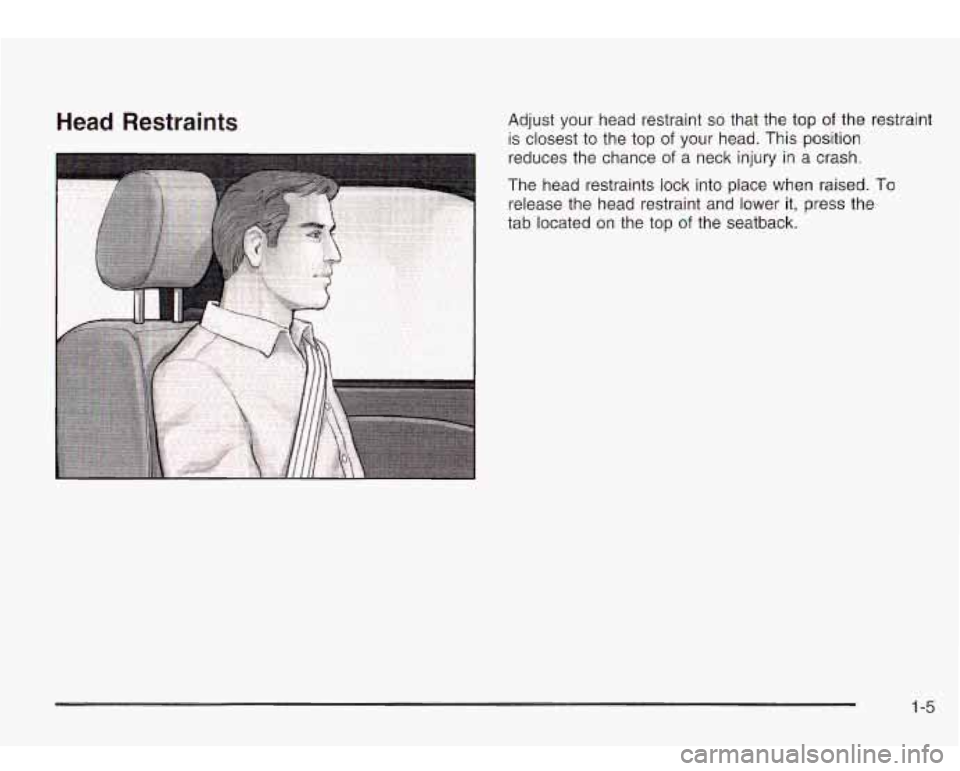
Head Restraints Adjust your head restraint so that the top of the restraint
is closest to the top
of your head. This position
I reduces the chance of a neck injury in a crash.
The head restraints
lock into place when raised. To
release the head restraint and lower it, press the
tab located on the top
of the seatback.
I -5
Page 21 of 410
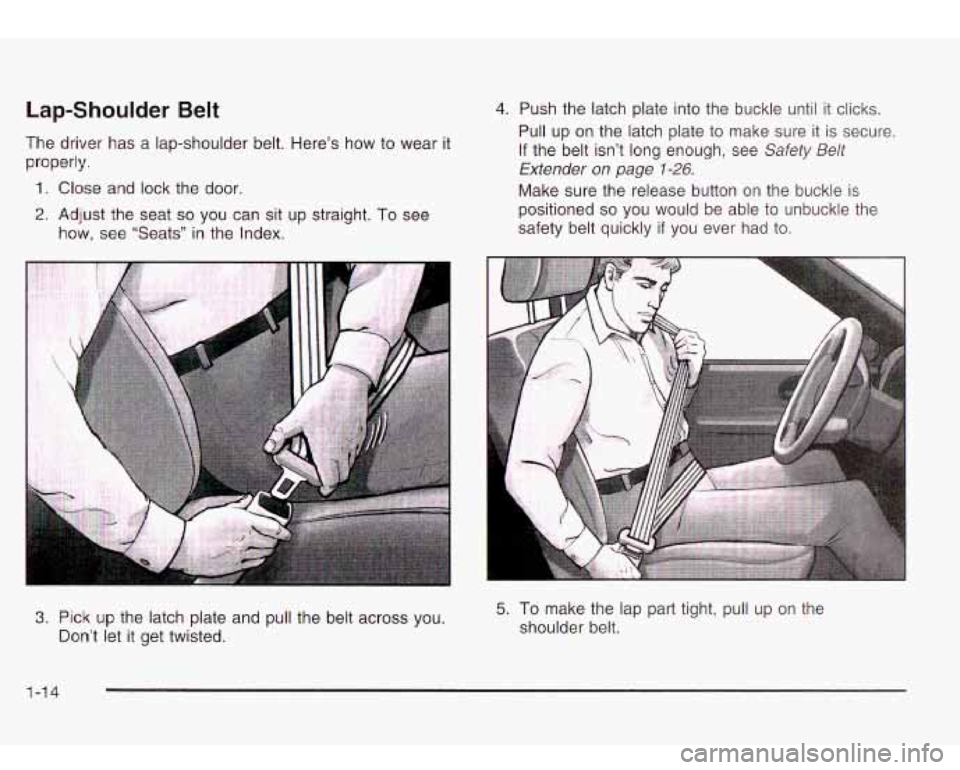
Lap-Shoulder Belt
The driver has a lap-shoulder belt. Here’s how to wear it
properly.
1. Close and lock the door.
2. Adjust the seat so you can sit up straight. To see
how, see “Seats” in the Index.
4. Push the latch plate into the buckle until it clicks.
Pull up on the latch plate to make sure it is secure.
If the belt isn’t long enough, see Safety Belt
Extender on page 1-26.
Make sure the release button on the buckle is
positioned
so you would be able to unbuckle the
safety belt quickly
if you ever had to.
3. Pick up the latch plate and pull the belt across you.
Don’t let it get twisted.
5. To make the lap part tight, pull up on the
shoulder belt.
1-14
Page 22 of 410
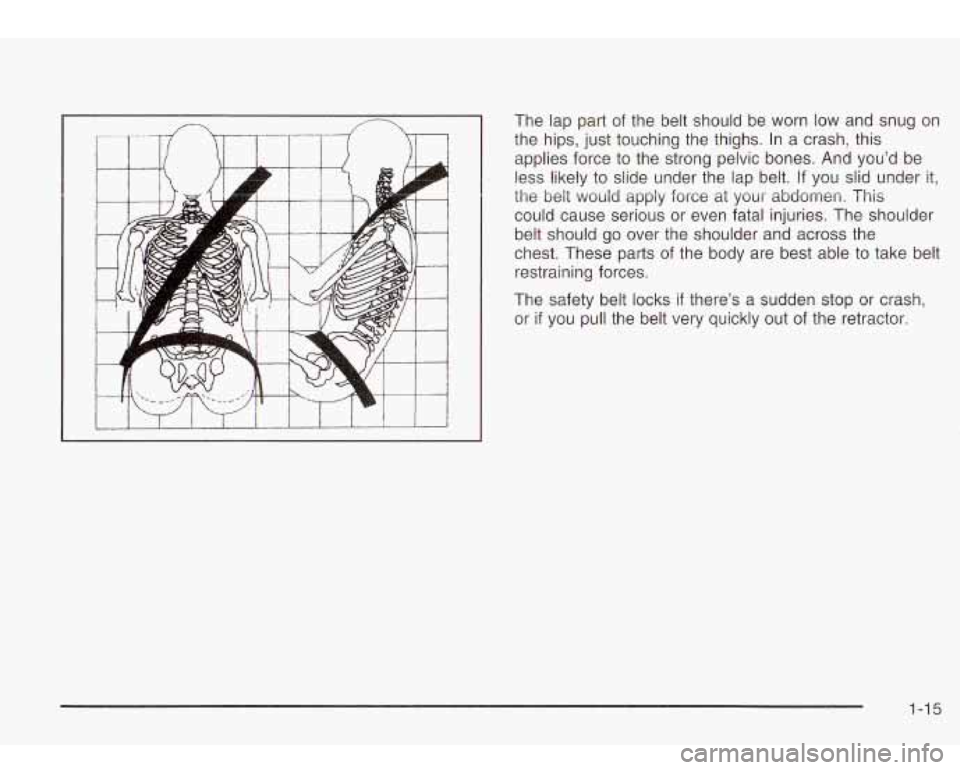
The lap part of the belt should be worn low and snug on
the hips, just touching the thighs. In a crash, this
applies force to the strong pelvic bones. And you’d be
less likely to slide under the lap belt.
If you slid under it,
the belt would apply force at your abdomen. This
could cause serious or even fatal injuries. The shoulder
belt should go over the shoulder and across the
chest. These parts of the body are best able to take belt
restraining forces.
The safety belt locks
if there’s a sudden stop or crash,
or
if you pull the belt very quickly out of the retractor.
1-15
Page 28 of 410
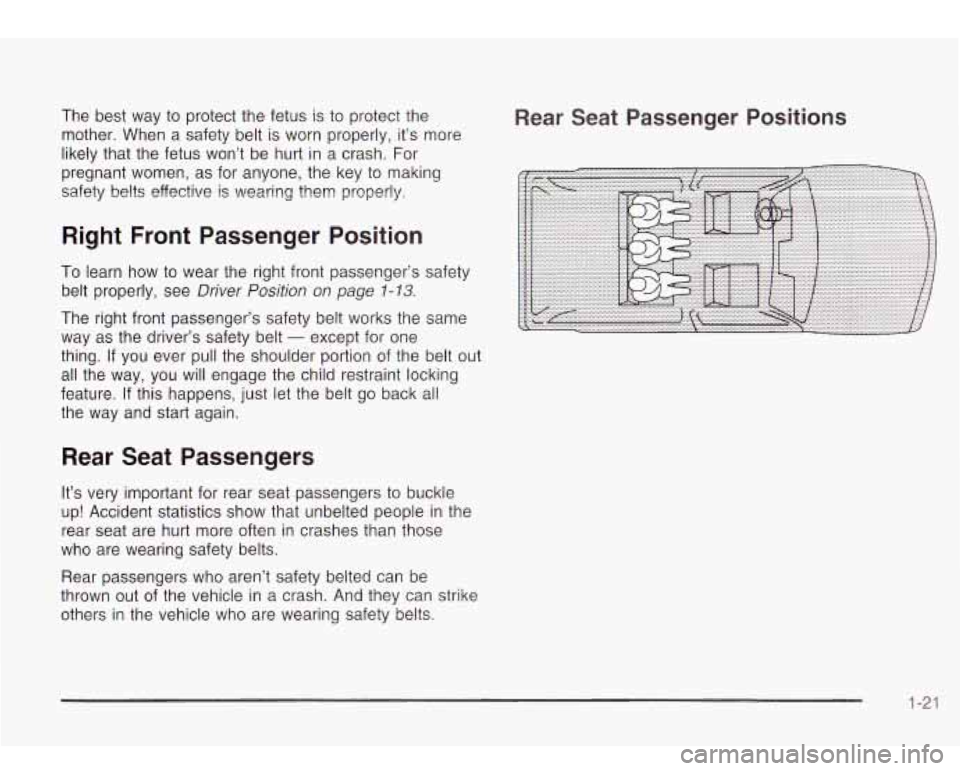
The best way to protect the fetus is to protect the
mother. When a safety belt is worn properly, it’s more
likely that the fetus won’t be hurt in a crash. For
pregnant women, as for anyone, the key to making
safety belts effective
is wearing them properly.
Right Front Passenger Position
To learn how to wear the right front passenger’s safety
belt properly, see
Driver Position on page 1-13.
The right front passenger’s safety belt works the same
way as the driver’s safety belt
- except for one
thing. If you ever
pull the shoulder portion of the belt out
all the way, you will engage the child restraint locking
feature. If this happens, just let the belt go back all
the way and start again.
Rear Seat Passengers
It’s very important for rear seat passengers to buckle
up! Accident statistics show that unbelted people in the
rear seat are hurt more often in crashes than those
who are wearing safety belts.
Rear passengers who aren’t safety belted can be
thrown out of the vehicle in a crash. And they can strike
others in the vehicle who are wearing safety belts.
Rear Seat Passenger Positions
1-21
Page 29 of 410
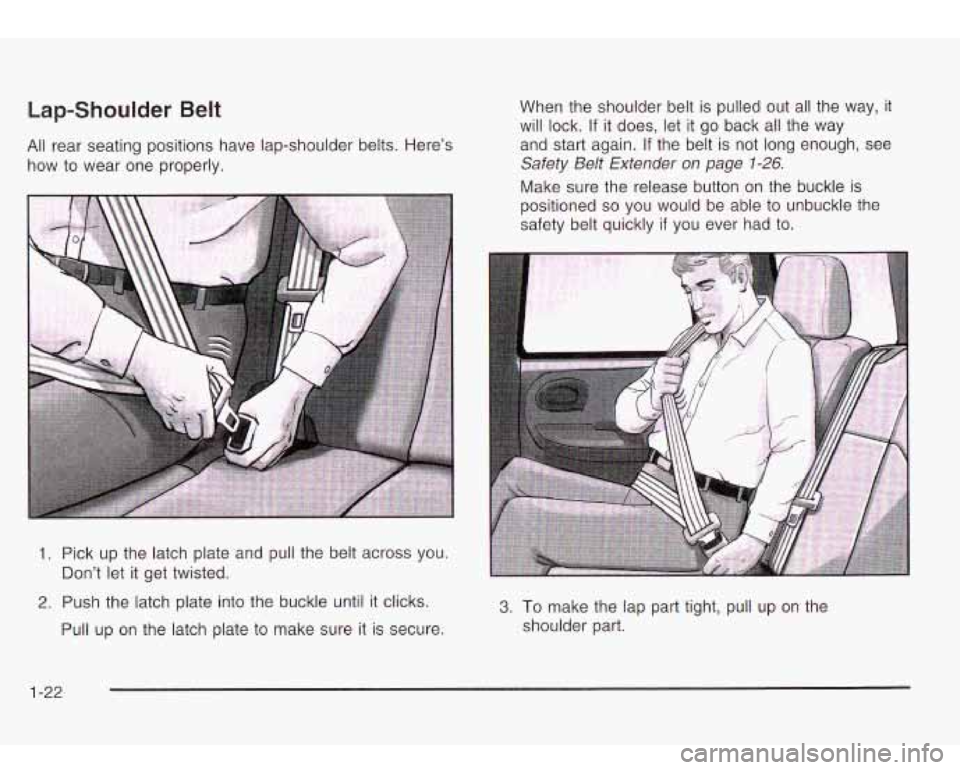
Lap-Shoulder Belt
All rear seating positions have lap-shoulder belts. Here’s
how to wear one properly. When
the shoulder belt is pulled out all the way,
it
will lock. If it does, let it go back all the way
and start again. If the belt is not long enough, see
Safety Belt Extender on page 1-26.
Make sure the release button on the buckle is
positioned
so you would be able to unbuckle the
safety belt quickly
if you ever had to.
1. Pick up the latch plate and pull the belt across you.
2. Push the latch plate into the buckle until it clicks.
Don’t let
it get twisted.
Pull up on the latch plate to make sure it is secure.
3. To make the lap part tight, pull up on the
shoulder part.
1-22
Page 48 of 410
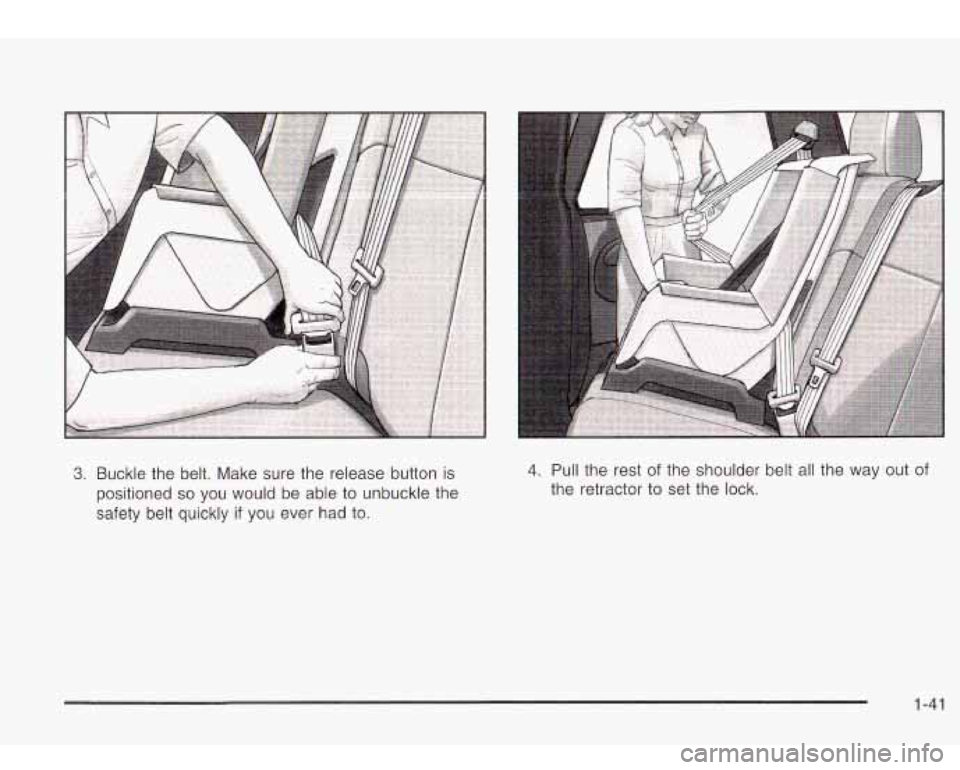
3. Buckle the belt. Make sure the release button is
positioned so you would be able to unbuckle the
safety belt quickly
if you ever had to.
4. Pull the rest of the shoulder belt all the way out of
the retractor to set the lock.
1-41
Page 51 of 410
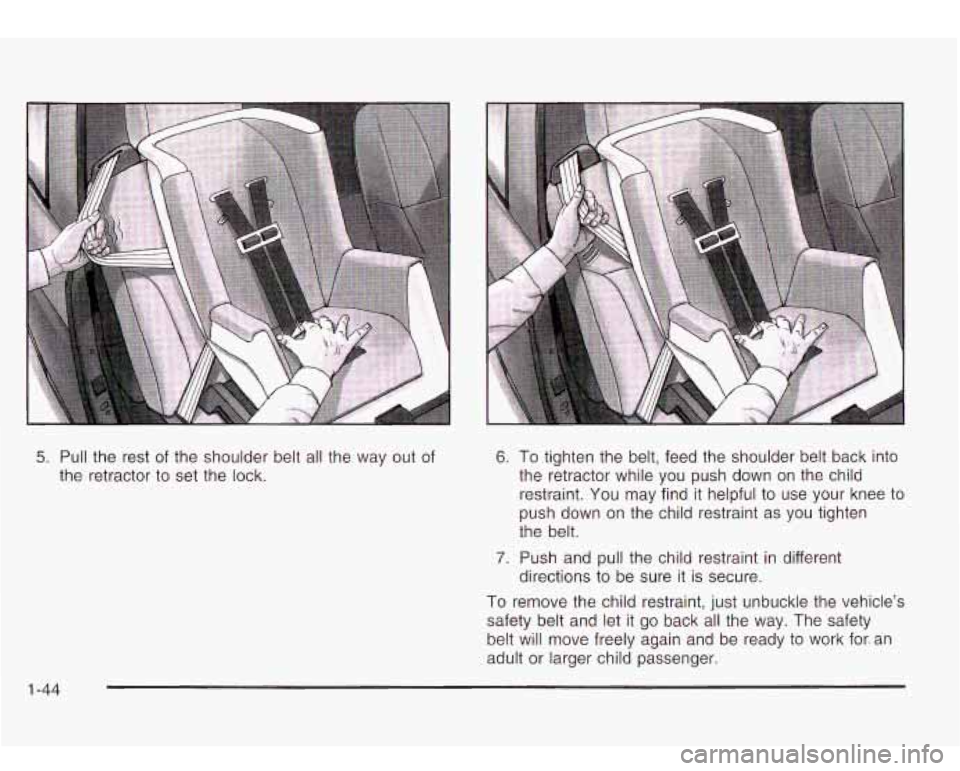
5. Pull the rest of the shoulder belt all the way out of
the retractor
to set the lock.
6. To tighten the belt, feed the shoulder belt back into
the retractor while you push down on the child
restraint. You may find it helpful
to use your knee to
push down on the child restraint as you tighten
the belt.
7. Push and pull the child restraint in different
directions
to be sure it is secure.
To remove the child restraint, just unbuckle the vehicle’s
safety belt and let it go back all the way. The safety
belt will move freely again and be ready
to work for. an
adult
or larger child passenger.
1 -44
Page 58 of 410
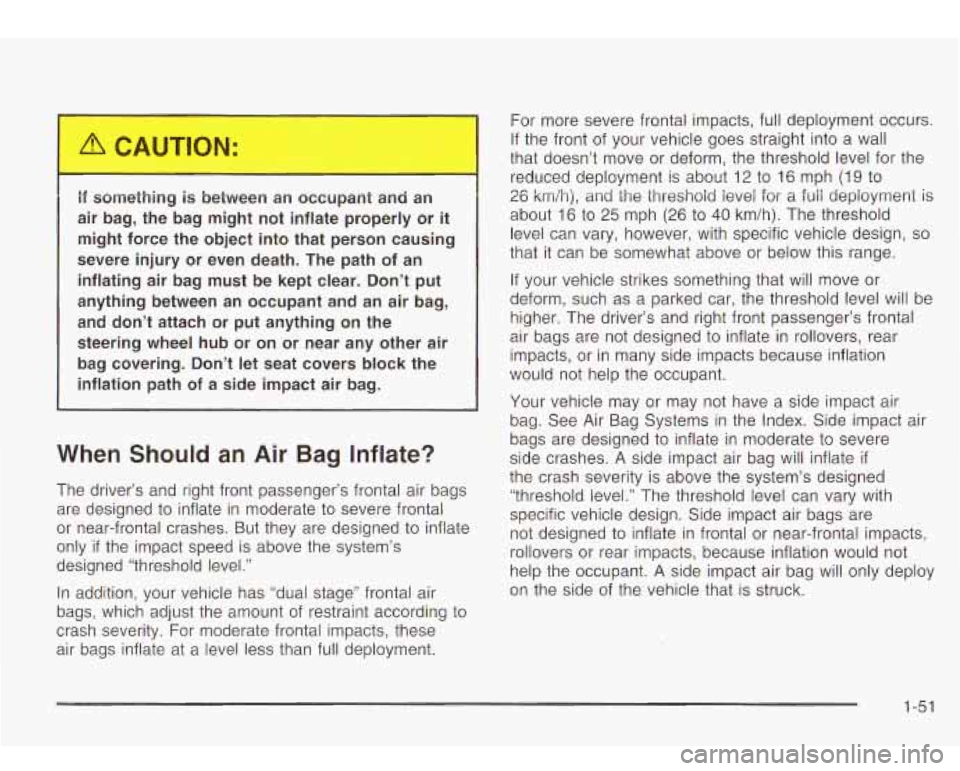
I
It something is between an occupant and an
air bag, the bag might not inflate properly or it
might force the object into that person causing
severe injury or even death. The path of an
inflating air bag must be kept clear. Don’t put
anything between an occupant and an air bag,
and don’t attach or put anything on the
steering wheel hub or on or near any other air
bag covering. Don’t let seat covers block the
inflation path
of a side impact air bag.
When Should an Air Bag Inflate?
The driver’s and right front passenger’s frontal air bags
are designed to inflate in moderate
to severe frontal
or near-frontal crashes. But they are designed to inflate
only
if the impact speed is above the system’s
designed “threshold level.”
In addition, your vehicle has “dual stage” frontal air
bags, which adjust the amount of restraint according
to
crash severity. For moderate frontal impacts, these
air bags inflate at a level less than full deployment. For more severe frontal impacts,
full deployment occurs.
If the front of your vehicle goes straight into a wall
that doesn’t move or deform, the threshold level for the
reduced deployment
is about 12 to 16 mph (1 9 to
26 km/h), and the threshoid levei for a full deployment is
about
16 to 25 mph (26 to 40 km/h). The threshold
level can vary, however, with specific vehicle design,
so
that it can be somewhat above or below this range.
If your vehicle strikes something that will move or
deform, such as a parked car, the threshold level will be
higher. The driver’s and right front passenger’s frontal
air bags are not designed
to inflate in rollovers, rear
impacts, or in many side impacts because inflation
would
not help the occupant.
Your vehicle may or may not have a side impact air
bag. See Air Bag Systems in the Index. Side impact air
bags are designed to inflate in moderate to severe
side crashes.
A side impact air bag will inflate if
the crash severity is above the system’s designed
“threshold level.” The threshold level can vary with
specific vehicle design. Side impact air bags are not designed
to inflate in frontal or near-frontal impacts,
rollovers or rear impacts, because inflation would not
help the occupant. A side impact air bag will only deploy
on the side of the vehicle that is struck.
1-51
Page 60 of 410
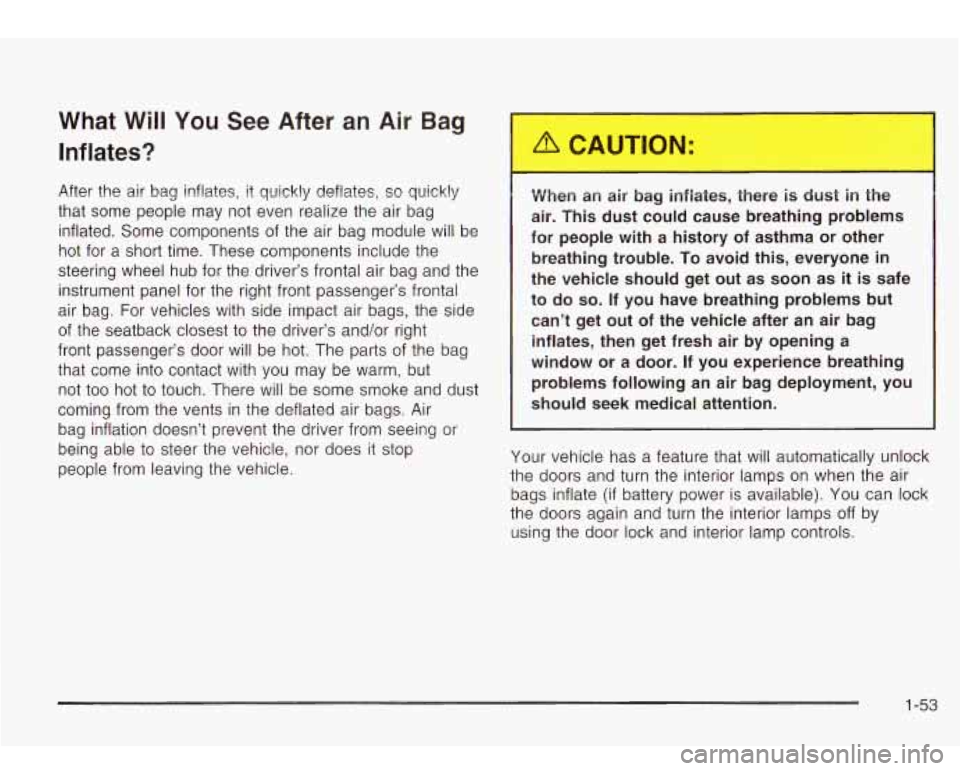
What Will You See After an Air Bag
Inflates?
After the air bag inflates, it quickly deflates, so quickly
that some people may not even realize the air bag
inflated. Some components of the air bag module will be
hot for a short time. These components include the
steering wheel hub for the driver’s frontal air bag and the
instrument panel for the right front passenger’s frontal
air bag. For vehicles with side impact air bags, the side
of the seatback closest
to the driver’s and/or right
front passenger’s door will be hot. The parts of the bag
that come into contact with you may be warm, but
not
too hot to touch. There will be some smoke and dust
coming from the vents in the deflated air bags. Air
bag inflation doesn’t prevent the driver from seeing or
being able to steer the vehicle, nor does it
stop
people from leaving the vehicle. When an
air bag inflates, there
is dust in the
air. This dust could cause breathing problems
for people with a history of asthma or other
breathing trouble.
To avoid this, everyone in
the vehicle should get out as soon as
it is safe
to do
so. If you have breathing problems but
can’t get out of the vehicle after an
air bag
inflates, then get fresh air by opening a
window or
a door. If you experience breathing
problems following an
air bag deployment, you
should seek medical attention.
Your vehicle has a feature that will automatically unlock
the doors and turn the interior lamps on when the air
bags inflate
(if battery power is available). You can lock
the doors again and turn the interior lamps
off by
using the door
lock and interior lamp controls.
1-53